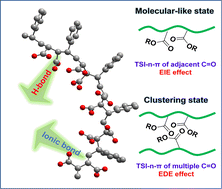Long-lived room temperature phosphorescence from amorphous non-traditional intrinsic clusteroluminescence polymers†
Abstract
Non-traditional intrinsic clusteroluminescence (CL) polymers with persistent room-temperature phosphorescence (RTP) properties have recently attracted considerable attention owing to the availability of versatile preparation methods and their excellent processability. Herein, a series of poly(styrene-alt-maleic anhydride) (PSMA) hydrolysates with blue fluorescence and green RTP were prepared. The experimental results show that the through-space n–π interaction (TSI-n–π) among intra-/intermolecular carbonyl groups is generated through the induction of hydrogen bonding or ionic bonding, which is the underlying cause of RTP emission. The transition from excitation-dependent emission (EDE) to excitation-independent emission (EIE) with decreasing concentrations indicates that the TSI-n–π of adjacent carbonyls in PSMA-H and hydrolyzed polymaleic anhydride solutions dominates the CL. Theoretical calculations further demonstrate that the phenyl group can induce the aggregation of adjacent carbonyl groups to produce TSI-n–π in the single molecule state, but it does not participate in the carbonyl cluster. This work affords a platform for revealing the nature of CL and TSIs and provides a simple and practical synthetic route for the preparation of RTP materials.



 Please wait while we load your content...
Please wait while we load your content...